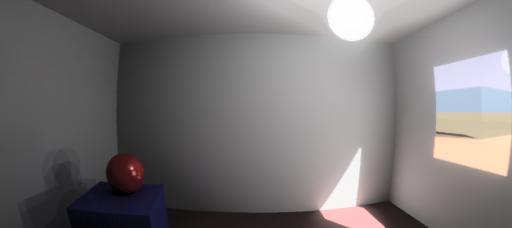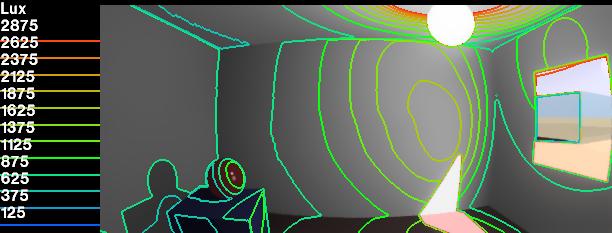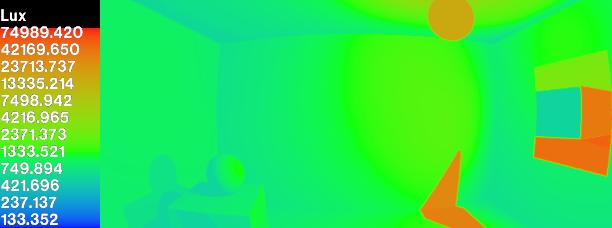
Sample Radiance image through a simulated fisheye lens, luminance corrected for human vision. Note the multiple reflections and shadows; the "building" seen through the window is a box of mirror glass reflecting the simulated ground and sky.
Because there is no way to investigate this hypothesis by direct measurement, we chose to build a lighting model, and because the space mixes electric light and daylight, we chose to use computer modelling.
Radiance is a set of software tools designed for the modelling of physical light. When used carefully by a skilled designer, the program solves the radiance equation, which models light in a space with sufficient accuracy to predict light levels which can be used to evaluate the space
Radiance takes as input building surface geometry, building materials, building luminaire information, and sun and sky information.
| Modeling the space |
Retrieve drawings and other forms of physical data about Special Collections Room from physical plant, building documentation room, web, library, and so on.
Take additional measurements and record physical character of materials and room on site.
Design 3-D AutoCAD model of space.
Import 3-D model into Radiance.
|
| Test the model |
Take readings on site for one single day. Note quality of daylight.
Simulate the seasonal conditions in Radiance.
Compare measurements with calculated values.
Re-test, re-evaluate, re-design model.
|
| Test hypothesis |
Generate late winter afternoon data with the model. If there is time, also generate night data.
Evaluate late winter afternoon data.
(If there is time) review data with users and find out if they agree with the model, and generate ideas for a next step, perhaps a redesign.
|

Sample Radiance image through a simulated fisheye lens, luminance corrected for human vision. Note the multiple reflections and shadows; the "building" seen through the window is a box of mirror glass reflecting the simulated ground and sky.

Same space, showing lines of constant illuminance.

Same space, showing illuminance in false color on a logarithmic scale, to accomodate both exterior and interior brightness.
Luminance was measured with a Minolta Spotmeter F, a photographic light meter. Illuminance was measured using a standard 18% neutral (grey) test card. For each location we took two luminance measurements; one of the subject surface and one of the grey card. While the Kodak® reference states that photographic meters are only provide accurate absolute luminance measurement in typical sunny outdoor lighting, they are always reliable sources of relative luminance information, since that is what is important for reliable photographic exposure.
Light meters are calibrated in photographic units, which are based on log2 illuminance; both f-stops and shutter speeds go in increments of doubling or halving exposure. Hence, to find the reflectivity of a material, one meters the grey card, meters the material in the same light, computes the difference of the numbers, and computes 18% * 2 difference.
These we did by eye with a Benjanmin Moore® swatchbook, and matched the colors with computer generated colors on a calibrated monitor. To compute RGB reflectance values, required for our modelling tools, we inserted the reflectivity into Photoshop's "brightness" setting, then read off RGB values, providing scale RGB values for a color of the same hue and saturation as the matched color.
Word to the wise: monitor color drifts, so even if your monitor is calibrated, recalibrate it before you try this; one of us forgot to do this and ended up with a heavy green cast in his swatches, which we had to remeasure.